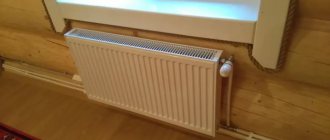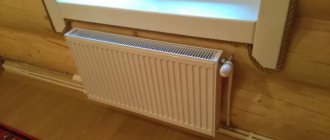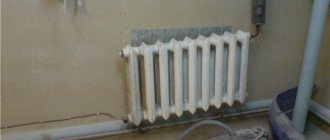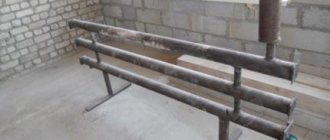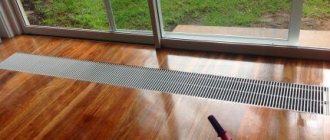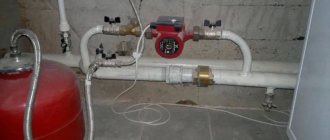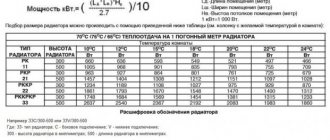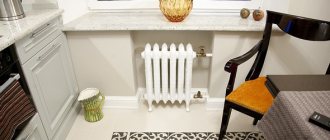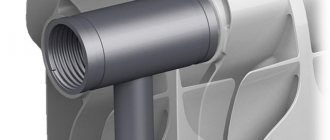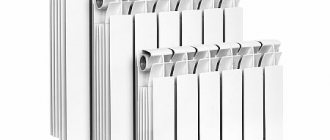The heating system is the large, warm “heart” of the house and a complex engineering structure that cannot be approximated and requires competent engineering calculations. After all, all this is not just radiators and pipes, but a serious issue of the microclimate in the house, aesthetics and energy saving.
Types of heating radiators for apartments
Not all radiators on the market today are suitable for installation in an apartment with a central heating system, so you should approach your choice responsibly. To understand how to choose the right heating radiators, let's look at their main types.
The difference between an autonomous heating system and a central one
In 2022, GOST 31311-2005 Heating appliances was adopted. From this document it follows that radiators cannot be sold without their laboratory confirmed compliance with the declared characteristics. Therefore, the first thing you need to do when choosing a device is to find out whether there is mandatory certification.
The document defines a radiator as a heating device that releases heat by convection and radiation. This definition is suitable for devices in both city apartments and private houses: they perform the same functions. But the requirements for them are different, because in individual houses radiators are part of an autonomous heating system, and it differs from central heating in almost every way.
Compared to a central heating system, an autonomous one:
- The operating pressure on the entire system is much lower, the load on the radiators will be gentle, their very thick walls will not be a big advantage here;
- There can be no water hammer in an autonomous heating system;
- In an autonomous heating system, heat loss is much lower than in a central heating system, they are somewhere around zero, so the coolant always heats up much more;
- But the owner of the house can set the temperature of the coolant himself, and not exceed the required maximum that is set for this type of heater;
- The coolant in an autonomous heating system can be antifreeze - non-freezing liquids. They are especially often used in those houses that may not be heated for a long time in winter. When freezing, antifreeze, unlike water, will not rupture radiators.
- The autonomous heating system is calculated taking into account the area of the house. A small building is one thing, but a huge cottage is quite another.
How do the features and nuances of a central heating system affect the service life of radiators?
Central heating system
Before you start choosing a radiator for your apartment, you should take into account some of the nuances of the central heating system. Of course, central heating has more advantages than disadvantages. No need to bother with choosing and installing boilers or installing a chimney. The cost of utilities is easily controlled by installing a meter. But there are also disadvantages that affect the choice of batteries.
- The carrier always contains aggressive substances that negatively affect the material of pipes and batteries. Most often, it is corrosion that causes a destructive effect on the inner layer of radiators, reducing their service life. For preventive purposes, some utilities add lignosulfonate powder to water tanks, which does not have the best effect on the service life of radiators.
- The water that goes through heating pipes often contains fine sand, clay, and lime. Gradually, this small debris wipes the metal from the inside. If the inner layer is rough, this will shorten the service life much faster.
- One of the enemies of heating radiators in apartments is pressure drops, so-called water hammer. This, of course, negatively affects the condition of the batteries. Air jams created by the unstable operation of the central line gradually lead to cracking and rupture of the metal. But many modern radiators are equipped with safety valves that allow you to regulate the pressure in the pipes and thus combat pressure instability.
- The temperature instability of the heating system has the greatest impact on the internal part of the battery. Cast iron has the ability to expand when heated and contract when the temperature drops, which leads to cracking of the inner layer. Therefore, it is these batteries that are most vulnerable to temperature changes.
Therefore, when choosing a radiator for heating an apartment, be guided by these points and take into account the operation of the highway and local housing and communal services.
Types of radiators
But the features of an autonomous heating system are not all that needs to be taken into account when choosing radiators. Heating devices for a private home are divided into groups according to design features, material of manufacture, and the principle of heat transfer.
- According to their design features, radiators can be solid or sectional;
- According to the material of manufacture, they are divided into cast iron, aluminum, steel and bimetallic;
- According to the principle of heat transfer - radiating thermal energy, convection and combined.
Main characteristics of a typical radiator
Regardless of the complexity of the heating system, the main task is to maintain the set temperature in the house or apartment. The heating radiator plays a key role in this, carrying out heat exchange between the air in the room and the coolant.
Uniform heating, efficient heat transfer, microclimate maintenance, stable operation - these are the main requirements for a heating battery.
In residential premises, single, panel or sectional twin radiators are installed that do not emit toxins when heated
The main parameters influencing the choice of a specific model:
- System operating pressure. Depends on whether the device is connected to an autonomous or centralized network. It is arranged on a gravity or forced principle. On average it varies from 3 to 10 bar or in a similar atmosphere range.
- Thermal power. A characteristic required to calculate the thermal power required to heat a room. It is also needed for selecting individual components of sectional batteries. Approximately 1 kW is required to process 10 m².
- Modularity. The quality inherent in prefabricated radiators, which makes it possible to assemble and disassemble the device to suit individual requirements.
- Speed of reaction to tº. More precisely, the ability to respond to changes in coolant temperature. period of time for cooling and warming up.
- Possibility of equipping with automation. Devices that monitor weather conditions and independently eliminate air jams.
The devices now presented for sale ensure free circulation of the coolant liquid throughout the system. They are characterized by corrosion resistance and attractive appearance.
Sectional radiators differ in the shape and size of the sections, ensuring the supply of the required amount of thermal energy
The thermal efficiency of a radiator depends on the energy dissipation surface area. A flat metal convector has a much smaller area compared to a sectional aluminum convector of the same geometric size. Because the latter radiates heat over the entire area of the fins.
Cast iron
Cast iron radiators are a classic, the most popular heating devices over the last hundred years. Long accordions of seven or eight sections can be seen in many retro photographs of Soviet apartments. Even then they were reliable, like a rock, withstanding any external mechanical impact and high pressure from the inside; they served for 50 years, got so hot that you couldn’t touch them, were resistant to corrosion and did not stop working even when they were “poorly heated” and the coolant temperature was low.
They are made from cast iron grade SCH 12-28, which is quite resistant to corrosion, using gaskets made of heat-resistant rubber - thanks to them, the products maintain tightness even when heated to 130 degrees.
But “cast iron” somehow looks antediluvian, they have a high heat capacity, many people talk about the sharp corners of the sections and the rough, unaesthetic casting surface. The best models of cast iron heating radiators are devoid of these shortcomings and will decorate any private home, some of them are even quite elegant, with smooth front surfaces and factory primer, with two- and three-column sections, which allows you to optimally reduce the width of the radiator for a given heat transfer.
TeploNetUser FORUMHOUSE
Cast iron radiators will never go out of style. Only the appearance will change.
A modern cast iron battery consists of several hollow sections, usually seven or eight, hermetically assembled together, with horizontal channels through which the coolant passes. Radiators can be one-, two- and three-channel. Their sizes are regulated by special GOST 8690-94 Cast iron heating radiators, according to which
- the distance between nipple holes should be from 300 to 800 mm;
- product height from 400 to 900 mm;
- depth from 100 to 160 mm.
Technical characteristics are given in the product labeling: this is how the MS-140-580-0.9-7 labeling is read: this is a product with a depth of 140 mm, a height of 580 mm, with a working pressure of 0.9 MPa, which consists of seven sections. This radiator fully complies with GOST.
The number of sections is simply calculated based on the area of the room (although there are also precise, complex and labor-intensive calculation methods that take into account many circumstances, from the region - winter is one thing in Moscow, and another in Irkutsk - to the number of windows in the room). A simple calculation is done like this: to heat a square meter of area, you need 100 W, therefore, by multiplying the area of the room by 100, we will find out how much heat is needed. Then we divide this value by the thermal power of one section of the selected model from the selected manufacturer.
The formula for calculating the number of sections of a cast iron battery is: multiply the area of the room by one hundred and divide by the thermal power of the section.
For a room of 21 square meters. meters according to this formula you will need 7.5 sections of a 160W radiator. It's better to round to eight than to seven.
There is nothing particularly difficult about installing cast iron batteries. Like all types of radiators, they must be installed at a certain distance from the wall, floor and window sill. These distances are regulated by SP 73.13330.2012 “SNiP 3.05.01-85. Internal sanitary systems of buildings."
- From the floor 60 mm;
- From the bottom surface of the window sill – 50 mm;
- 25 mm from the wall plaster surface (but the manufacturer may specify other dimensions).
RoaromaFORUMHOUSE user
The radiator will not operate at full capacity if the distance between it and the wall is not maintained. They passed, it’s not even discussed.
A cast-iron radiator is hung from the wall on metal supports, but sometimes, due to the design features of the house and the heavy weight of the device, it is placed on legs. Floor radiators are often stylized as antique ones, decorated with intricate castings; such products, even domestically produced, have a refreshingly high cost, but fit perfectly into a classic interior.
But when deciding on cast iron radiators, you should remember this important feature: they have high thermal inertia; They both heat up and cool down slowly. It will not be possible to quickly change the temperature in a room heated by cast iron radiators.
But in houses that are heated by solid fuel boilers, the disadvantages of cast iron become advantages: the large heat capacity in this case is rather a plus.
Lord LLC User FORUMHOUSE
Aluminum convectors quickly heat the air, but also quickly cool themselves. This is the reason for my choice of cast iron. If there was gas, I would install aluminum.
VashnovoselFORUMHOUSE user
Well, cast iron takes longer to heat up, well, inertia, so this is better with a solid fuel boiler and permanent residence!
And for houses connected to main gas, cast iron batteries, according to reviews from our users, are not the best choice.
TraksFORUMHOUSE User
My neighbor last year threw out cast iron and installed aluminum. Now pay less for gas. His house is well insulated; at a temperature of -25 degrees outside there is no need to heat the coolant to 90 degrees, 50-60 is enough.
Additional installation tips
The efficient, reliable operation of the heating system is influenced not only by the correct choice of the type of heating radiator.
There are a few simple installation rules:
- The distance to the wall is at least 4 cm.
- The distance to the floor and window sill is at least 10 cm.
- The size is no more than 75% of the width of the opening being constructed.
Distances affect the correct distribution of air flows, ensuring uniform and rapid heating of the room. In addition, distances are important for fire safety if the floor consists of flammable materials (parquet, boards, linoleum).
The radiator is placed in window niches, in places accessible for inspection, maintenance, and repair. The standard radiator width is 75% narrower than the opening
The use of a decorative screen will reduce the efficiency to 15-20%. Incorrect connections to the supply and return pipes will reduce productivity by up to 20%. The most effective solution is to connect the supply pipe to the top of the radiator, and the outlet to the bottom of the radiator.
Information on methods of connecting heating devices, taking into account the requirements of building regulations, is given here.
Steel
There are steel radiators
- Panel
- Sectional
- Tubular
Panel
In individual housing construction, panel radiators are most often used, as they are the most inexpensive and common among all steel ones. They consist of panels (usually two) in which coolant circulates. Convection elements may or may not be installed between the panels. Panel radiators with convection elements work like convectors, or rather, they have the functions of both a convector and a radiator, 50/50. The difference is that a radiator transfers heat to the objects surrounding it, while a convector heats the air. And such universal devices heat the room evenly, both above and below, and do it quickly.
Panel radiators without convectors work like regular cast iron radiators, but unlike cast iron ones, they are very easy to clean. Therefore, they are installed in clinics, kindergartens, etc.
High-quality panel panels work on any coolant, and they have a very high efficiency, they effectively transfer heat even at a coolant temperature of +40- +45 degrees (steel radiators will last a long time if the coolant temperature does not exceed +70 degrees, and exceed the indicators by + 100 is not recommended).
But - only high-quality ones, when it comes to steel panel radiators; experts do not even advise messing with cheap options.
vergun_lg User FORUMHOUSE
On the question of the durability of steel radiators: I had to cut off pre-war heating in a private house, the pipes were installed as yesterday, there was no corrosion. When choosing a steel panel, I would advise you to pay attention to the thickness of the panel and the anti-corrosion coating - God saves the best.
The thickness of the walls determines whether the device can withstand high pressure in the heating system. A cheap device with a 0.5 mm wall will not withstand it, but a radiator with a 1.25 mm wall will only withstand it.
Also, a steel panel heater is selected according to its dimensions: its width must be equal to at least 50% of the window opening. And we must take into account the peculiarities of heating wiring: buy radiators with lower outlets for connection if the wiring is hidden in the floor, and with outlets on the sides if the house has a classic wiring. The radiator passport always indicates all the requirements for the heating system: pressure, pH level of the coolant, etc.
VseobinUser FORUMHOUSE
The advantages of steel panels: they cool longer than aluminum and bimetallic radiators, and they have a wide selection of sizes and modifications. Cons: if a panel radiator leaks, you will have to replace it entirely.
Another disadvantage: high requirements for the quality of the coolant due to the tendency of steel to corrosion, and instability to mechanical damage; such radiators must be loaded, unloaded and transported with extreme caution.
The power of a steel radiator depends on its type. You need to read the numbers on the radiator nameplates: the first two are the type of radiator, the second is the width, the third is the height. With width and height everything is clear, the first two numbers are of interest: it is either 10, or 11, or 20, or 21, or 33.
11 – single-section, with one convector, power is 1.1 kW. 22 – two-section, with two convectors, power 1.9 kW. 33 – three-section, with three convectors, power 2.7 kW.
Steel tubular
These are expensive radiators, and they are used quite rarely, in designer interiors, etc.
Hortek SPbForumHouse Member
The tubes are more elegant, but this is a matter of overall design.
These radiators are made of steel tubes with thick walls, connected into beautiful rectangular grilles. From the inside, the metal is protected from corrosion by polymer materials. Therefore, their use is widespread even in houses with central heating, where water hammer is possible, because the operating pressure for this type is 15 atmospheres, and the maximum permissible operating temperature of the coolant is 130 degrees.
They heat up evenly and retain heat for a long time. Their only obvious drawback is their high price.
Sectional
Sectional steel radiators are rarely used for heating individual houses - they are quite expensive. This is a structure of several sections with vertical and horizontal channels. Outwardly, they resemble a cast iron radiator; in fact, they are a symbiosis of panel and tubular radiators, and their main advantage is that they can withstand higher pressure in the system (10-16 atmospheres).
The number of radiator sections can be changed, it can be increased if the power of the device is clearly not enough to cope with the heating of the room; or reduce it if it becomes hot in the house after insulation work.
The disadvantage of such devices is the increased number of joints in the structure, which can even lead to sealing.
Floor convectors
A new solution among heating devices is convectors hidden in the floor, consisting of a heat exchanger, a duct and a decorative grille. Their coolant pipes are copper, and their fins are aluminum. There are also models with a steel tubular core (“Breeze” from KZTO). In-floor radiators are especially good with panoramic glazing. They are used in airports, car dealerships, and sports facilities (for example, swimming pools).
+ Pros:
- Durability and simplicity of design, low weight.
- They are not subject to corrosion.
- They take up little space.
- They are practically invisible.
- Easy to install and clean.
- Uniform heating of the room.
- Protects against glass fogging.
- Minuses:
- Large installation length.
- Inability to use forced ventilation.
- Little heat dissipation.
- Uneconomical.
Manufacturers: OPLFLEX (Czech Republic), Mohlenhoff (Germany), JAGA (Belgium), IMP KLIMA (Slovenia), KZTO (Russia).
Main characteristics:
- Pressure (working) – 10-16 bar.
- Thermal power – 130-10000 watts.
- Hot water temperature (maximum) – 110-130 degrees.
Aluminum
In individual heating systems, aluminum radiators are used even more often than cast iron ones. Modern radiators are made of aluminum alloys; they consist of sections (and you can assemble a radiator of the required power from them).
They are inexpensive, very light, quite durable and reliable, and can withstand high pressure (there are models that can withstand 20 atmospheres). They have a high heat transfer coefficient (much higher than cast iron), they are easy to install, and they are not inertial, which is why temperature regulators are installed in such batteries.
“Lyuminki” could be called the best heating radiators for a private home, but they have one big drawback - poor corrosion resistance, which means high demands on the quality of the coolant. Therefore, such radiators are not recommended for installation in high-rise apartments and private houses with central heating. Central heating systems are filled with an alkaline coolant with a pH level greater than 8, and often of rather dubious quality; this is too much for sensitive aluminum radiators: an incorrectly selected coolant leads to corrosion, and the protective layer that protects the aluminum collector from the inside is destroyed.
In autonomous heating systems, you need to ensure that the coolant does not contain mechanical impurities (filters solve this problem) and corresponds to a normal pH level (approximately 7). In a neutral environment, radiator aluminum is not subject to corrosion! If you control the quality of the coolant, there should be no problems with aluminum radiators.
An aluminum radiator can be protected from chemical corrosion only by monitoring the quality and composition of the coolant.
If you leave this issue to chance, it won’t be long before the heating system depressurizes.
If the coolant is water, then you must monitor its hardness. And it is better not to reduce the hardness with reagents, but to fill the system with distilled water.
To summarize: for autonomous heating systems in which the quality of the coolant can be controlled, aluminum radiators are quite suitable. It is important to buy quality products and ensure that the characteristics of the antifreeze comply with the manufacturer's recommendations.
novor113FORUMHOUSE user
A good aluminum is as good as a good steel radiator, but it is cheaper and has a good design. And for a steel one with a good design you will pay twice as much.
Conclusions and useful video on the topic
Useful tips from experts will help you understand the choice of heating device:
The best choice of heating radiator can be considered the one that achieves the greatest comfort and coziness. The radiator can be invisible or, on the contrary, be part of the overall design. But the most important thing is reliability and no hassle.
You can tell us about how you chose a radiator to replace old batteries in an apartment or to furnish a new home in the block below. Please write comments, ask questions, share useful tips and photos on the topic of the article. We are interested in your opinion.
Bimetallic
Bimetallic radiators are those that are made of aluminum and steel. But unscrupulous manufacturers even call bimetallic devices in which only the vertical channels of the collector are made of steel. This is incorrect, a real bimetallic radiator has a manifold made entirely of high strength carbon steel, in fact it is a steel manifold inside a section of aluminum. But in a private house, where the owners have the opportunity to monitor the quality of the coolant, this may not be so important, although the service life of bimetallic batteries is longer than that of aluminum ones. This can be considered an additional advantage, but bimetallic ones are also more expensive.
VseinstrumentiUser FORUMHOUSE
Bimetallic ones are stronger. I agree that it is usually more profitable to use aluminum radiators in a private home.
Editor's Choice
Among bimetallic radiators, two models deserve special attention: Global STYLE PLUS 500 and Royal Thermo PianoForte 500 . The first is interesting for its increased safety margin. The second is notable for its unusual design, which makes the radiators an original part of the interior design.
Among aluminum devices, RO Global ISEO 500 for adapting the design to operating conditions in the Russian Federation.
Among steel ones, a very interesting solution was implemented in KZTO Harmony 2-500-12 - the radiator will not only warm you up, but will also be an excellent addition to the minimalist interior design.
If you want sophisticated cast iron classics, then you should pay attention to EXEMET Modern 3-745/600 . Compared to other models of this type, this is one of the most affordable.
How to calculate power
The power of any radiator for an individual home is calculated based on the fact that to heat an average room with one window, one door and a shelf height of less than three meters, the coolant temperature should be about 70 degrees, and to heat one square meter you need 95-125 kW. The parameters of this scheme are adjusted if real conditions differ from the average: in a room with second light, the battery power should be greater by as many times as the ceiling height is higher than average; if the ceilings are low, the power is reduced.
If the coolant temperature is less than 70 degrees, then the power of the radiators should increase (15-20% for every 10 degrees). In corner rooms with several windows, the average radiator power is increased by one and a half times. It should also be borne in mind that the most effective radiator connection scheme is when the coolant is supplied to it at the upper side inlet, and the return line is connected diagonally to the lower outlet. All other connection schemes slightly, by 5-10%, but reduce the heat transfer of the batteries.
It is impossible to increase the number of radiator sections indefinitely. There should not be more than ten of them; no coolant will warm up such a battery.
Criteria for choosing radiators for an apartment
The decision to purchase a certain type of radiator is influenced not only by its technical parameters and the operating conditions of the central heating system. There is a certain procedure for choosing the right heating batteries.
It is imperative to pay attention to the following nuances:
- Operating pressure . Each product has a passport, where this parameter must be indicated by the manufacturer. Its value should be at least 1.5 times the actual pressure in the heating structure. It is precisely its differences that most often cause the breakdown of modern devices.
- Possibility to prevent water hammer . This has a strong impact on the battery life. In apartments where there is central heating, it is impossible to protect yourself from them. Therefore, preference should be given to those units that have a high degree of resistance to water hammer.
- Number of sections . Some batteries can be expanded during use. When it is difficult to decide on the size of the structure, you need to pay attention to such radiators.
- Device power . Not all batteries are able to cope with creating a comfortable microclimate in the house in regions where the outdoor temperature drops below - 40 degrees. Therefore, information about which batteries are the warmest is so important. Some foreign products are designed for 80-90 degrees, and for areas with severe winters it is advisable to select models with a heating temperature of up to 120-130 degrees.
- Coolant quality . Domestic central heating systems circulate water whose quality is so poor that it damages the internal surfaces of radiators. Therefore, it is better to purchase batteries with thick walls.
- Appearance and product design . When choosing batteries for rooms that have undergone modern renovations, it is unlikely that anyone will want to install bulky structures. From the rich assortment on the market, you can always choose an original model.
- Length of service life . Replacing heating appliances in an apartment is an expensive undertaking, so new products must last at least 20 years.
- Easy to install . This criterion is only relevant when the heating equipment is installed independently. It is impossible to install a heavy cast-iron structure alone, but there will be no problems with lightweight panel radiators.
Information about what kind of heating radiators there are for an apartment will not be superfluous for those who want to purchase new appliances. Experts do not advise saving much on their purchase, since cheap products can cause an accident in the house and cause a lot of trouble for residents of an apartment building.
Heating devices of single-pipe systems
An important feature of the horizontal “Leningrad” is the gradual decrease in temperature in the main line due to the admixture of coolant cooled by the batteries. If 1 ring line serves more than 5 devices, the difference at the beginning and end of the distribution pipe can reach 15 °C. The result is that the latest radiators emit less heat.
Single-pipe closed circuit - all heaters are connected to 1 pipe
To ensure that long-distance batteries transfer the required amount of energy to the room, make the following adjustments when calculating heating power:
- Select the first 4 radiators according to the instructions above.
- Increase the power of the 5th device by 10%.
- Add another 10 percent to the calculated heat transfer of each subsequent battery.
Explanation. The power of the 6th radiator increases by 20%, the seventh by 30, and so on. An expert will tell you in detail in the video why to expand the last batteries of a single-pipe Leningradka:
How to find out the real heat transfer
When selecting heating devices in an online store, it is difficult to find real power indicators for a panel or one section. It is more profitable for sellers to declare maximum heat transfer, which is practically unattainable when heating a country cottage or apartment. According to the passport, the water temperature in the supply pipeline should reach 90 degrees, the return line - 70 °C, room air - 20 °C.
Reference. In modern household heat generators, the heating temperature is limited to 80...85 degrees.
We recommend selecting sections based on heat transfer as follows:
- Open the official website of the manufacturer of the battery you like and download the operating instructions for the device. It indicates exactly at what temperature difference DT the radiator produces the nominal amount of heat. Focus on the 70/50 °C mode.
Power of Kermi steel panels depending on size and temperature conditions - example table - If there are no instructions, take the manufacturer's data as truth and multiply the heat transfer by an increasing factor of 1.5-1.8. If you make a one and a half supply, you definitely won’t go wrong.
- Select the latest radiators of a single-pipe system with a double reserve, since they receive the least amount of thermal energy.
The most accurate selection method is to calculate heat transfer at a given temperature pressure. The calculation algorithm is described in detail in the corresponding material.
Calculation of heating batteries per area
One of the most important issues in creating comfortable living conditions in a house or apartment is a reliable, correctly calculated and installed, well-balanced heating system. That is why creating such a system is the most important task when organizing the construction of your own home or when carrying out major renovations in a high-rise apartment.
Despite the modern variety of heating systems of various types, the leader in popularity is still a proven scheme: pipe circuits with coolant circulating through them, and heat exchange devices - radiators installed in the premises. It would seem that everything is simple, the batteries are located under the windows and provide the required heating... However, you need to know that the heat transfer from the radiators must correspond to both the area of the room and a number of other specific criteria. Thermal calculations based on the requirements of SNiP are a rather complex procedure performed by specialists. However, you can do it on your own, naturally, with acceptable simplification. This publication will tell you how to independently calculate heating radiators for the area of a heated room, taking into account various nuances.
Calculation of heating batteries per area
But, first, you need to at least briefly familiarize yourself with existing heating radiators - the results of the calculations will largely depend on their parameters.
Briefly about existing types of heating radiators
The modern range of radiators on sale includes the following types:
- Steel radiators of panel or tubular design.
- Cast iron batteries.
- Aluminum radiators of several modifications.
- Bimetallic radiators.
Steel radiators
This type of radiator has not gained much popularity, despite the fact that some models are given a very elegant design. The problem is that the disadvantages of such heat exchange devices significantly exceed their advantages - low price, relatively low weight and ease of installation.
Steel heating radiators have many disadvantages
The thin steel walls of such radiators do not have enough heat capacity - they heat up quickly, but also cool down just as quickly. Problems can also arise with water hammer - welded joints of sheets sometimes leak. In addition, inexpensive models that do not have a special coating are susceptible to corrosion, and the service life of such batteries is short - usually manufacturers give them a fairly short warranty in terms of service life.
In the vast majority of cases, steel radiators are a one-piece structure, and it is not possible to vary the heat transfer by changing the number of sections. They have a rated thermal power, which must be immediately selected based on the area and characteristics of the room where they are planned to be installed. An exception is that some tubular radiators have the ability to change the number of sections, but this is usually done to order, during manufacture, and not at home.
Cast iron radiators
Representatives of this type of battery are probably familiar to everyone from early childhood - these are the types of accordions that were previously installed literally everywhere.
The MS-140-500 cast iron radiator, familiar to everyone since childhood
Perhaps such MS-140-500 batteries were not particularly elegant, but they faithfully served more than one generation of residents. Each section of such a radiator provided a heat output of 160 W. The radiator is prefabricated, and the number of sections, in principle, was not limited by anything.
Modern cast iron radiators
There are currently many modern cast iron radiators on sale. They are already distinguished by a more elegant appearance, smooth outer surfaces that make cleaning easier. Exclusive versions are also produced, with an interesting relief pattern of cast iron casting.
With all this, such models fully retain the main advantages of cast iron batteries:
- The high heat capacity of cast iron and the massiveness of the batteries contribute to long-term retention and high heat transfer.
- Cast iron batteries, with proper assembly and high-quality sealing of connections, are not afraid of water hammer and temperature changes.
- Thick cast iron walls are little susceptible to corrosion and abrasive wear. Almost any coolant can be used, so such batteries are equally good for both autonomous and central heating systems.
If we do not take into account the external characteristics of old cast iron batteries, then the disadvantages include the fragility of the metal (accentuated impacts are unacceptable), the relative complexity of installation, which is associated largely with massiveness. In addition, not all wall partitions can support the weight of such radiators.
Aluminum radiators
Aluminum radiators, having appeared relatively recently, quickly gained popularity. They are relatively inexpensive, have a modern, quite elegant appearance, and have excellent heat dissipation.
When choosing aluminum radiators, you need to consider some important nuances
High-quality aluminum batteries can withstand pressures of 15 atmospheres or more and high coolant temperatures of about 100 degrees. At the same time, the thermal output from one section of some models sometimes reaches 200 W. But at the same time, they are lightweight (section weight is usually up to 2 kg) and do not require a large volume of coolant (capacity - no more than 500 ml).
Aluminum radiators are offered for sale as stacked batteries, with the ability to change the number of sections, and as solid products designed for a certain power.
Disadvantages of aluminum radiators:
- Some types are highly susceptible to oxygen corrosion of aluminum, with a high risk of gas formation. This places special demands on the quality of the coolant, which is why such batteries are usually installed in autonomous heating systems.
- Some aluminum radiators of a non-separable design, sections of which are made using extrusion technology, may, under certain unfavorable conditions, leak at the joints. In this case, it is simply impossible to carry out repairs, and you will have to replace the entire battery as a whole.
Of all aluminum batteries, the highest quality ones are those made using anodic oxidation of the metal. These products are practically not afraid of oxygen corrosion.
Externally, all aluminum radiators are approximately similar, so you need to read the technical documentation very carefully when making a choice.
Bimetallic heating radiators
Such radiators compete with cast iron ones in terms of reliability, and with aluminum ones in terms of thermal output. The reason for this is their special design.
The structure of a bimetallic heating radiator
Each section consists of two, upper and lower, steel horizontal collectors (item 1), connected by the same steel vertical channel (item 2). The connection into a single battery is made with high-quality threaded couplings (item 3). High heat transfer is ensured by the outer aluminum shell.
Steel internal pipes are made of metal that is not subject to corrosion or has a protective polymer coating. Well, under no circumstances does the aluminum heat exchanger come into contact with the coolant, and it is absolutely not afraid of corrosion.
This results in a combination of high strength and wear resistance with excellent thermal performance.
Prices for popular heating radiators
Heating radiators
Such batteries are not afraid of even very large pressure surges and high temperatures. They are, in fact, universal and suitable for any heating systems, however, they still show the best performance characteristics under conditions of high pressure in the central system - they are of little use for circuits with natural circulation.
Perhaps their only drawback is their high price compared to any other radiators.
For ease of reference, there is a table showing the comparative characteristics of radiators. Symbols in it:
- TS – tubular steel;
- Chg – cast iron;
- Al – ordinary aluminum;
- AA – aluminum anodized;
- BM – bimetallic.
| Chg | TS | Al | AA | BM | |
| Maximum pressure (atm.) | |||||
| working | 6-9 | 6-12 | 10-20 | 15-40 | 35 |
| crimping | 12-15 | 9 | 15-30 | 25-75 | 57 |
| destruction | 20-25 | 18-25 | 30-50 | 100 | 75 |
| Limitation on pH (hydrogen value) | 6,5-9 | 6,5-9 | 7-8 | 6,5-9 | 6,5-9 |
| Susceptibility to corrosion when exposed to: | |||||
| oxygen | No | Yes | No | No | Yes |
| stray currents | No | Yes | Yes | No | Yes |
| electrolytic couples | No | weak | Yes | No | weak |
| Section power at h=500 mm; Dt=70 ° , W | 160 | 85 | 175-200 | 216,3 | up to 200 |
| Warranty, years | 10 | 1 | 3-10 | 30 | 3-10 |
Video: recommendations for choosing heating radiators
You may be interested in information about what a bimetallic battery is
How to calculate the required number of heating radiator sections
It is clear that a radiator installed in the room (one or more) must provide heating to a comfortable temperature and compensate for the inevitable heat loss, regardless of the weather outside.
The basic value for calculations is always the area or volume of the room. The professional calculations themselves are very complex and take into account a very large number of criteria. But for household needs you can use simplified methods.
The simplest methods of calculation
It is generally accepted that to create normal conditions in a standard living space, 100 W per square meter of area is sufficient. Thus, you just need to calculate the area of the room and multiply it by 100.
Q = S × 100
Q – required heat transfer from heating radiators.
S – area of the heated room.
If you plan to install a non-separable radiator, then this value will become a guideline for selecting the required model. In the case where batteries are installed that allow the number of sections to be changed, another calculation should be made:
N = Q / Qсy
N – calculated number of sections.
Qс – specific thermal power of one section. This value must be indicated in the technical data sheet of the product.
As you can see, these calculations are extremely simple and do not require any special knowledge of mathematics - just a tape measure to measure the room and a piece of paper for calculations. In addition, you can use the table below - it shows already calculated values for rooms of different sizes and certain capacities of heating sections.
Section table
However, you need to remember that these values are for the standard ceiling height (2.7 m) of a high-rise building. If the height of the room is different, then it is better to calculate the number of battery sections based on the volume of the room. For this, an average indicator is used - 41 W of thermal power per 1 m³ of volume in a panel house, or 34 W in a brick house.
Q = S × h × 40 (34)
where h is the height of the ceiling above the floor level.
Further calculations are no different from those presented above.
Detailed calculation taking into account the characteristics of the room
Now let's move on to more serious calculations. The simplified calculation method given above can present a “surprise” to the owners of a house or apartment. When installed radiators do not create the required comfortable microclimate in residential premises. And the reason for this is a whole list of nuances that the considered method simply does not take into account. Meanwhile, such nuances can be very important.
So, the area of the room and the same 100 W per m² are again taken as a basis. But the formula itself already looks a little different:
Q = S × 100 × A × B × C × D × E × F × G × H × I × J
Letters from A to J conventionally indicate coefficients that take into account the characteristics of the room and the installation of radiators in it. Let's look at them in order:
A is the number of external walls in the room.
It is clear that the higher the contact area between the room and the street, that is, the more external walls there are in the room, the higher the overall heat loss. This dependence is taken into account by coefficient A :
- One external wall – A = 1.0
- Two external walls - A = 1.2
- Three external walls - A = 1.3
- All four external walls - A = 1.4
B – orientation of the room to the cardinal points.
The maximum heat loss is always in rooms that do not receive direct sunlight. This is, of course, the northern side of the house, and the eastern side can also be included here - the rays of the Sun appear here only in the mornings, when the luminary has not yet reached its full power.
The warming of rooms largely depends on their location relative to the cardinal directions.
The southern and western sides of the house are always heated by the Sun much more strongly.
Hence the values of coefficient B :
- The room faces north or east – B = 1.1
- Southern or western rooms – B = 1, that is, may not be taken into account.
C is a coefficient that takes into account the degree of insulation of the walls.
It is clear that heat loss from the heated room will depend on the quality of the thermal insulation of the external walls. The value of coefficient C is taken equal to:
- Average level - the walls are laid with two bricks, or their surface insulation is provided with another material - C = 1.0
- External walls are not insulated - C = 1.27
- High level of insulation based on thermal engineering calculations – C = 0.85.
D – features of the climatic conditions of the region.
Naturally, it is impossible to put all the basic indicators of the required heating power “with the same brush” - they also depend on the level of winter negative temperatures characteristic of a particular area. This takes into account the coefficient D. To select it, the average temperatures of the coldest ten days of January are taken - usually this value is easy to check with the local hydrometeorological service.
- – 35 °C and below – D= 1.5
- — 25 ÷ — 35 °С – D= 1.3
- up to – 20 °С – D= 1.1
- not lower than – 15 °С – D= 0.9
- not lower than – 10 °С – D= 0.7
E – coefficient of ceiling height of the room.
As already mentioned, 100 W/m² is an average value for standard ceiling heights. If it differs, a correction factor E :
- Up to 2.7 m – E = 1.0
- 2.8 – 3.0 m – E = 1.05
- 3.1 – 3.5 m – E = 1.1
- 3.6 – 4.0 m – E = 1.15
- More than 4.1 m – E = 1.2
F – coefficient taking into account the type of room located above
Setting up a heating system in rooms with cold floors is a pointless exercise, and owners always take action in this matter. But the type of room located above often does not depend on them in any way. Meanwhile, if there is a living or insulated room on top, then the overall need for thermal energy will decrease significantly:
- cold attic or unheated room – F= 1.0
- insulated attic (including insulated roof) – F= 0.9
- heated room – F= 0.8
G – factor taking into account the type of windows installed.
Different window designs are subject to heat loss differently. This takes into account the G factor:
- conventional wooden frames with double glazing – G= 1.27
- the windows are equipped with single-chamber double-glazed windows (2 glasses) – G= 1.0
- single-chamber double-glazed window with argon filling or double-glazed window (3 glasses) - G= 0.85
N – coefficient of glazing area of the room.
The total amount of heat loss also depends on the total area of windows installed in the room. This value is calculated based on the ratio of the window area to the room area. Depending on the result obtained, we find the coefficient H :
- Ratio less than 0.1 – H = 0.8
- 0,11 ÷ 0,2 – H = 0.9
- 0,21 ÷ 0,3 – H = 1.0
- 0,31÷ 0,4 – H = 1.1
- 0,41 ÷ 0,5 – H = 1.2
I is a coefficient that takes into account the radiator connection diagram.
Their heat transfer depends on how the radiators are connected to the supply and return pipes. This should also be taken into account when planning the installation and determining the required number of sections:
Diagrams for inserting radiators into a heating circuit
- a – diagonal connection, supply from above, return from below – I = 1.0
- b – one-way connection, supply from above, return from below – I = 1.03
- c – two-way connection, both supply and return from below – I = 1.13
- d – diagonal connection, supply from below, return from above – I = 1.25
- d – one-way connection, supply from below, return from above – I = 1.28
- e – one-sided bottom connection of return and supply – I = 1.28
J is a coefficient that takes into account the degree of openness of installed radiators.
Much also depends on how open the installed batteries are to free heat exchange with the room air. Existing or artificially created barriers can significantly reduce the heat transfer of the radiator. This takes into account the J factor:
The heat transfer of batteries is affected by the place and method of their installation in the room.
a – the radiator is located openly on the wall or not covered by a window sill – J = 0.9
b – the radiator is covered from above with a window sill or shelf – J = 1.0
c – the radiator is covered from above by a horizontal projection of the wall niche – J = 1.07
d – the radiator is covered from above by a window sill, and from the front side it is partially covered by a decorative casing – J = 1.12
d – the radiator is completely covered with a decorative casing – J = 1.2
⃰⃰⃰⃰⃰⃰⃰⃰⃰ ⃰⃰⃰⃰⃰⃰⃰⃰⃰ ⃰⃰⃰⃰⃰⃰⃰⃰⃰ ⃰⃰⃰⃰⃰⃰⃰⃰ ⃰⃰⃰⃰⃰⃰⃰⃰⃰ ⃰⃰⃰⃰⃰⃰⃰⃰⃰ ⃰⃰⃰⃰⃰⃰⃰⃰⃰ ⃰⃰⃰⃰⃰⃰⃰⃰
Well, finally, that's all. Now you can substitute the required values and coefficients corresponding to the conditions into the formula, and the output will be the required thermal power for reliable heating of the room, taking into account all the nuances.
After this, all that remains is to either select a non-separable radiator with the required thermal output, or divide the calculated value by the specific thermal power of one section of the battery of the selected model.
Surely, to many, such a calculation will seem overly cumbersome, in which it is easy to get confused. To make the calculations easier, we suggest using a special calculator - it already contains all the required values. The user can only enter the requested initial values or select the required items from the lists. The “calculate” button will immediately lead to an exact result, rounded up.
Calculator for accurate calculation of heating radiators
Go to calculations
The author of the publication, who is also the compiler of the calculator, hopes that the visitor to our portal received complete information and good help for independent calculations.
You may be interested in information on how to choose an electric boiler.
